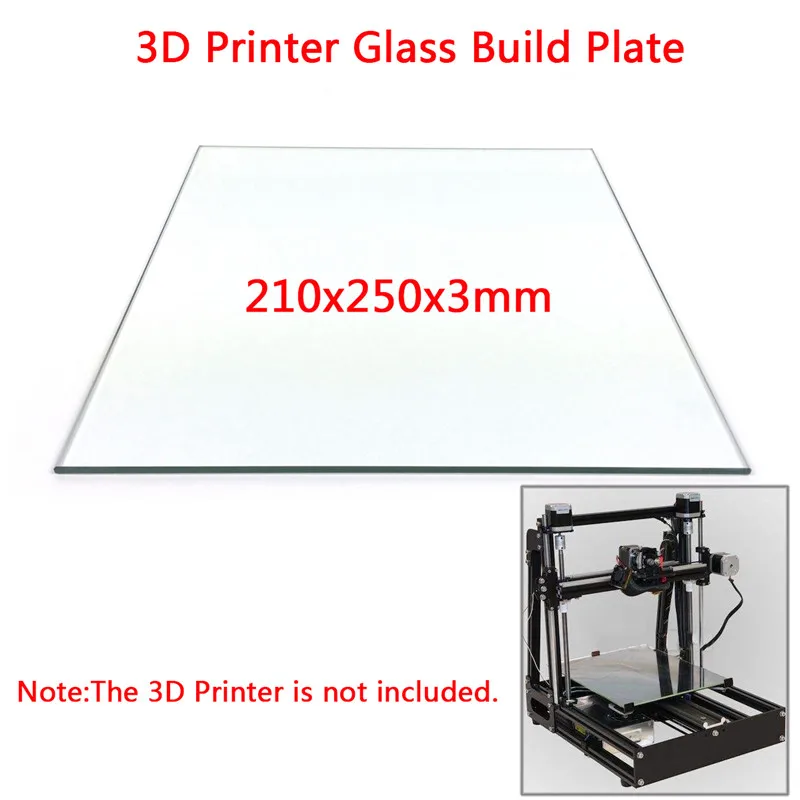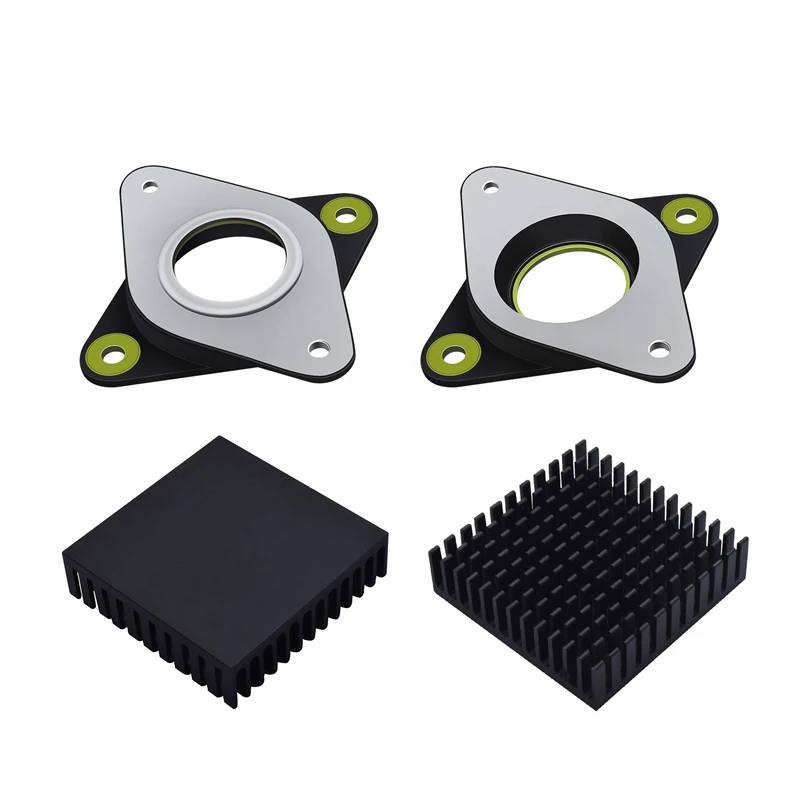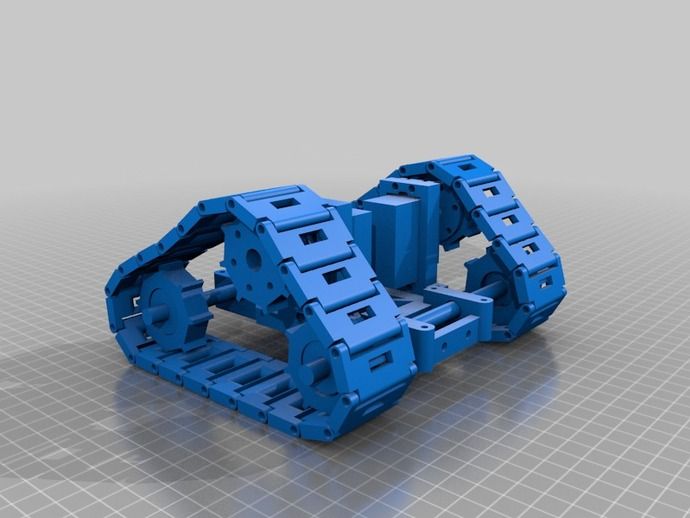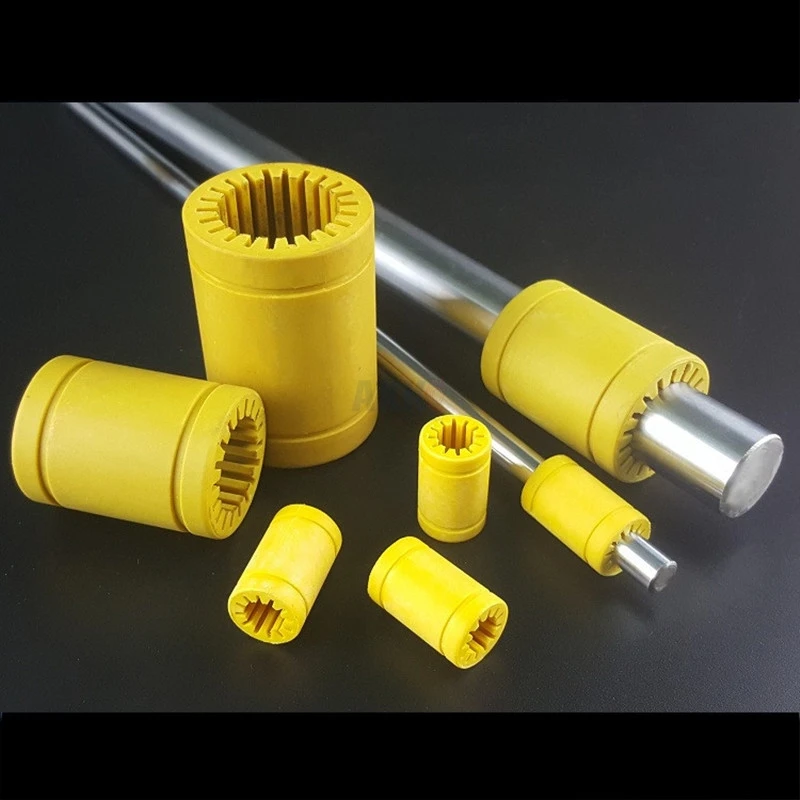3D print steel bridge
Long-awaited 3D-printed stainless steel bridge opens in Amsterdam
James Parkes | Leave a comment
A 12-metre 3D-printed pedestrian bridge designed by Joris Laarman and built by Dutch robotics company MX3D has opened in Amsterdam six years after the project was launched.
The bridge, which was fabricated from stainless steel rods by six-axis robotic arms equipped with welding gear, spans the Oudezijds Achterburgwal in Amsterdam's Red Light District.
Top: MX3D Bridge is located in the Red Light District. Above: it was 3D-printed from stainless steelNamed MX3D Bridge, it was designed by Dutch studio Joris Laarman Lab in collaboration with MX3D, a technology company co-founded by Laarman, and engineering firm Arup.
The structure used 4,500 kilograms of stainless steel, which was 3D-printed by robots in a factory over a period of six months before been craned into position over the canal this year.
Its curving S-shaped form and balustrades with lattice-style perforations were designed using parametric modelling software.
The bridge was constructed using robotic printers. Photo is by Adriaan de GrootThe team behind the bridge claimed the technique showed how 3D-printing technology can lead to more efficient structures that use less material.
"This robotic technology finally allows larger optimized designs to be 3D-printed in metal," said MX3D co-founder Gijs van der Velden.
"This causes significant weight reduction and reduced impact for parts manufactured in the tooling, oil and gas and construction industries."
It has perforated balustrades. Photo is by Jande GroenThe technique can lead to more sustainable structures, the team claimed. "The industry is facing a huge challenge in becoming carbon-neutral in 2050," said Arup structural engineer Stijn Joosten.
"By stepping up our game and the will to make a change as designers and engineers, we can bring the necessary innovation to make a difference in tomorrow's built environment.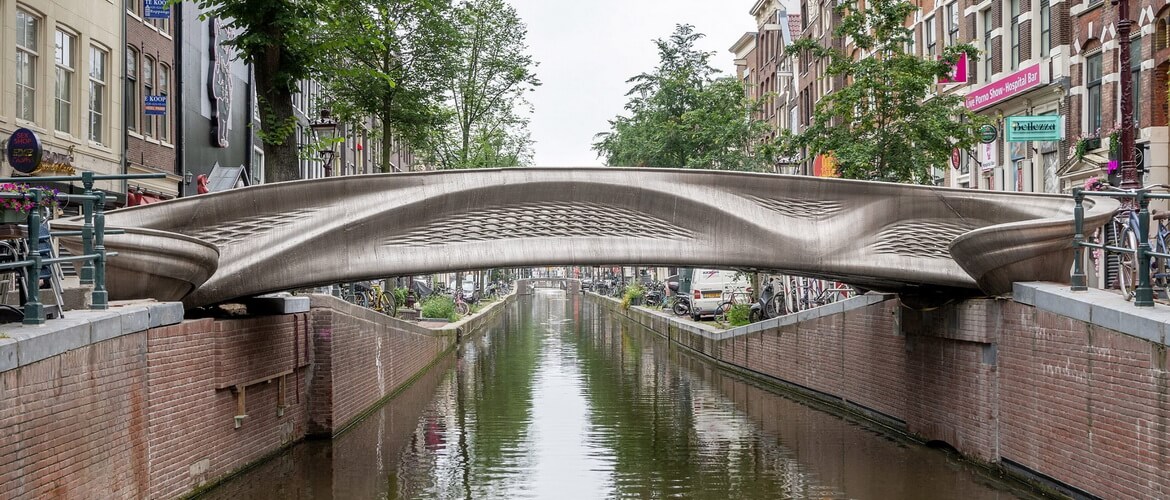 "
"
Joris Laarman's canal bridge in Amsterdam could take 3D printing "to a higher level"
However, architect Philip Oldfield calculated that the stainless steel used in the structure has 27.7 tonnes of embodied carbon.
"Stainless steel has an embodied carbon of 6.15kgCO2/kg," tweeted Oldfield, who is head of the art, design and architecture school at the University of New South Wales in Australia. "This bridge then has an #embodiedcarbon of at least 27.7 tonnes of CO2 to span a few metres."
The bridge was fitted with sensors. Photo is by Thijs WolzakThe Alan Turing Institute and Arup fitted the structure with a network of sensors that allows the bridge to collect data and build a digital twin to keep track of its performance and health.
The digital twin will monitor corrosion, load changes, environmental conditions and pedestrian use in efforts to further data-centric design.
It was made from 4,500 kilograms of stainless steel. Photo is by Thijs WolzakLaarman had the idea for the bridge after combining robotic arms with welding machines to create a machine capable of printing furniture. "By adding small amounts of molten metal at a time, we are able to print lines in mid-air," explained Laarman at the time.
"By adding small amounts of molten metal at a time, we are able to print lines in mid-air," explained Laarman at the time.
The welding machine later formed the basis of MX3D, which Laarman co-founded to explore the potential for printing larger-scale objects.
The bridge has undergone multiple iterations since the project was launched in 2015, with the opening originally slated for 2017.
The original plan was to print the structure across the canal in situ, with robots working from both banks welding the bridge beneath them until they met in the middle.
The final iteration saw the bridge built in two parts at an off-site facility. Its main span was completed in April 2018 with the deck printed in October that year.
The structure was strengthened to be more in line with council regulations and to protect the structure against any potential boat collisions.
First tenants move into 3D-printed home in Eindhoven
Although this is believed to be the first 3D-printed stainless steel bridge, bridges have previously been 3D printed from other materials. In 2017, construction company BAM Infra built what they claimed was the world's first 3D-printed concrete bridge.
In 2017, construction company BAM Infra built what they claimed was the world's first 3D-printed concrete bridge.
Photography is by Thea van den Heuvel unless stated otherwise.
Subscribe to our newsletters
Your email addressDezeen Debate
Our most popular newsletter, formerly known as Dezeen Weekly. Sent every Thursday and featuring a selection of the best reader comments and most talked-about stories. Plus occasional updates on Dezeen’s services and breaking news.
Dezeen AgendaSent every Tuesday and containing a selection of the most important news highlights. Plus occasional updates on Dezeen’s services and breaking news.
Dezeen DailyA daily newsletter containing the latest stories from Dezeen.
New! Dezeen In DepthSent on the last Friday of every month, Dezeen in Depth features original feature articles, interviews and opinion pieces that delve deeper into the major stories shaping architecture and design.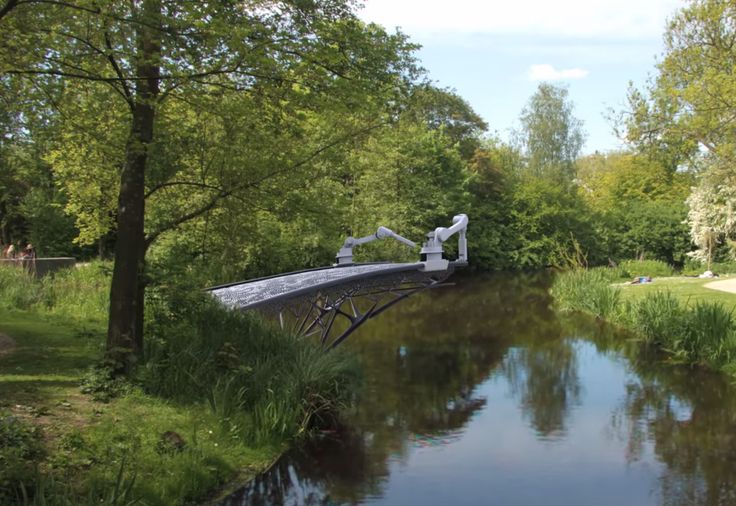
Daily updates on the latest design and architecture vacancies advertised on Dezeen Jobs. Plus occasional news.
Dezeen AwardsNews about our Dezeen Awards programme, including entry deadlines and announcements. Plus occasional updates.
Dezeen Events GuideNews from Dezeen Events Guide, a listings guide covering the leading design-related events taking place around the world. Plus occasional updates.
We will only use your email address to send you the newsletters you have requested. We will never give your details to anyone else without your consent. You can unsubscribe at any time by clicking on the unsubscribe link at the bottom of every email, or by emailing us at [email protected].
For more details, please see our privacy notice.
Thank you!
You will shortly receive a welcome email so please check your inbox.
You can unsubscribe at any time by clicking the link at the bottom of every newsletter.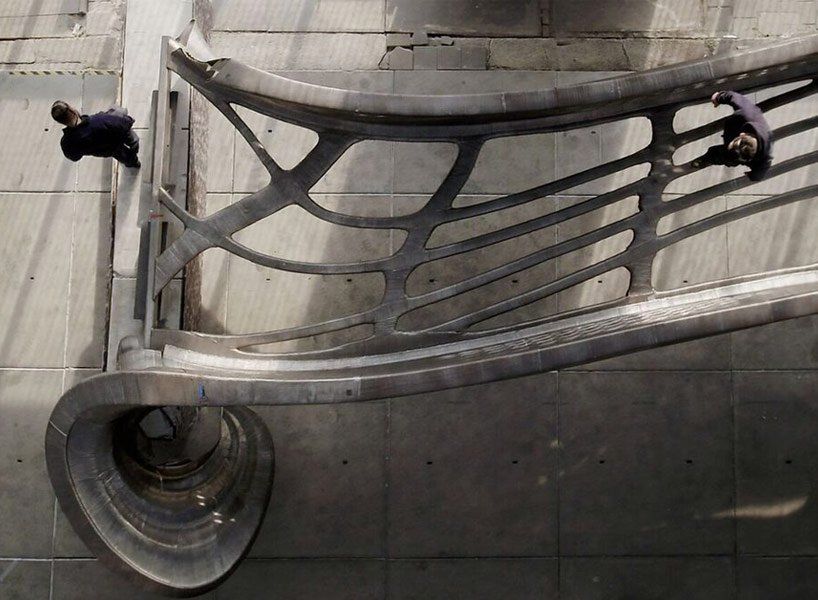
MX3D | MX3D Bridge
PreviousNext
12345
MX3D 3D printed a fully functional stainless steel bridge to cross one of the oldest and most famous canals in the center of Amsterdam, the Oudezijds Achterburgwal. We equip typical industrial robots with purpose-built tools and develop the software to control them. The unique approach allows us to 3D print strong, complex and graceful structures out of metal. The goal of the MX3D Bridge project is to showcase the potential applications of our multi-axis 3D printing technology.
The MX3D Bridge is designed by Joris Laarman Lab, Arup is the lead structural engineer, ArcelorMittal provides the metallurgical expertise, Autodesk assists with their knowledge on digital production tools, Heijmans is our construction expert, Lenovo supports us with computational hardware, ABB is the robotics specialist, Air Liquide & Oerlikon know everything about welding and lastly, Plymovent protects the air our employees breath whilst AMS and TU Delft do invaluable research.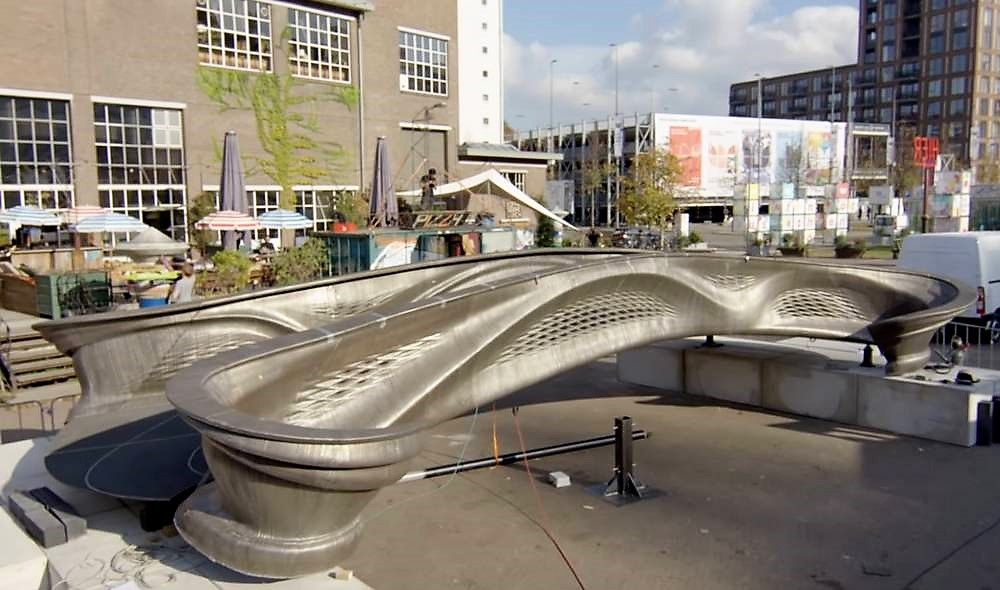 Gemeente Amsterdam is the first customer of our collaborative bridge building department.
Gemeente Amsterdam is the first customer of our collaborative bridge building department.
PreviousNext
12345
PreviousNext
12
PreviousNext
1234
…
MX3D 3D printed a 12 meter long stainless steel pedestrian bridge, and is now placed and crossing one of the Amsterdam’s canals in the old city center since 2021. We have teamed up with a consortium of mathematicians, IoT specialists and e to develop a smart sensor network to monitor the bridge’s health in real time. A great example of data centric engineering.
The partners joining the MX3D project include: Autodesk, The Alan Turing Institute and the Amsterdam Institute for Advanced Metropolitan Solutions (AMS).
The team from The Alan Turing Institute is responsible for designing and installing a sensor network on the bridge.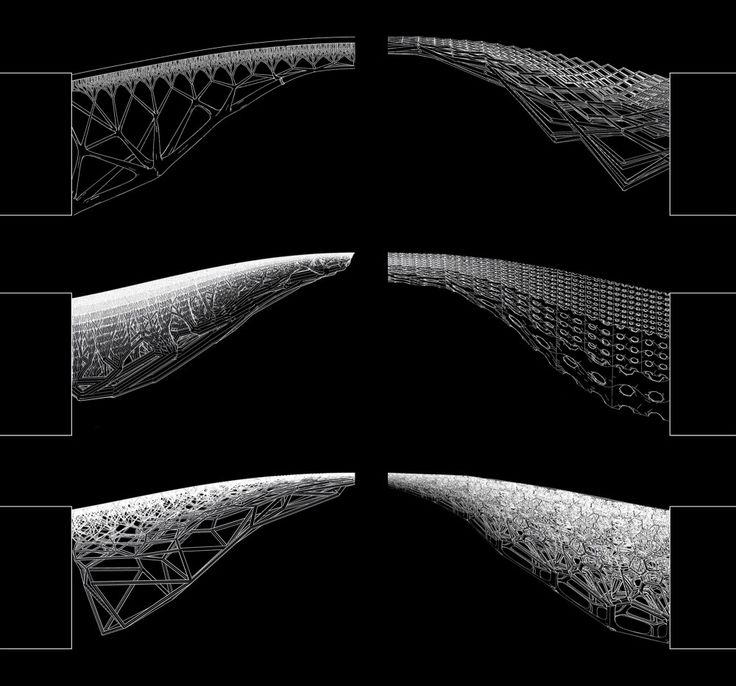 These sensors will collect structural measurements such as strain, displacement and vibration, and will measure environmental factors such as air quality and temperature, enabling engineers to measure the bridge’s health in real time and monitor how it changes over its lifespan. This data will also allow us to “teach” the bridge to understand what is happening on it, how many people are crossing it and how quickly.
These sensors will collect structural measurements such as strain, displacement and vibration, and will measure environmental factors such as air quality and temperature, enabling engineers to measure the bridge’s health in real time and monitor how it changes over its lifespan. This data will also allow us to “teach” the bridge to understand what is happening on it, how many people are crossing it and how quickly.
The data from the sensors will be input into a ‘digital twin’ of the bridge, a living computer model that will reflect the physical bridge with growing accuracy in real time as the data comes in. The performance and behaviour of the physical bridge can be tested against its digital twin, which will provide valuable insights to inform designs for future 3D printed metallic structures. It will also enable the current 3D bridge to be modified to suit any required changes in use, ensuring it is safe for pedestrians under all conditions.
Autodesk is supplying the cloud services that will power the bridge’s data collection and processing. Autodesk is also working with The Alan Turing Institute researchers to develop machine learning algorithms that will enable the bridge to interpret and to react intelligently to its environment. AMS will be implementing new ways to use, visualize and connect the bridge’s data to other sources of environmental data in the Metropolitan Area of Amsterdam.
Autodesk is also working with The Alan Turing Institute researchers to develop machine learning algorithms that will enable the bridge to interpret and to react intelligently to its environment. AMS will be implementing new ways to use, visualize and connect the bridge’s data to other sources of environmental data in the Metropolitan Area of Amsterdam.
www.smartbridgeamsterdam.com
TIMELINE
What the first 3D printed steel bridge looks like
Trends
TV channel
Pro
Investments
Events
RBC+
New economy
Trends
Real estate
Sport
Style
National projects
City
Crypto
Debating club
Research
Credit ratings
Franchises
Newspaper
Special projects St. Petersburg
Petersburg
Conferences St. Petersburg
Special projects
Checking counterparties
RBC Library
Podcasts
ESG index
Policy
Economy
Business
Technology and media
Finance
RBC CompanyRBC Life
RBC Trends
Photo: Mashable / YouTube
The world's first 3D printed steel bridge has been installed in Amsterdam. The project was ready three years ago, but the installation of the bridge was constantly delayed
What's happening
- On July 15, the world's first 3D printed steel bridge was opened in Amsterdam.
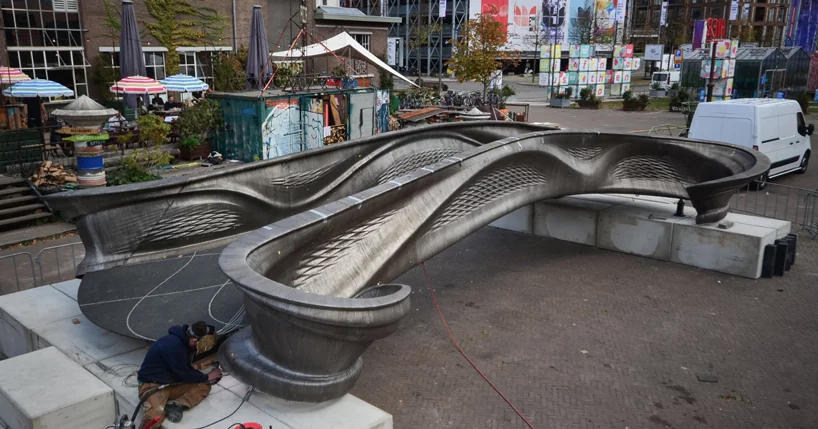 It connects the embankments of the Oudesijds Achterburgwal canal. The grand opening was attended by Queen Maxima of the Netherlands.
It connects the embankments of the Oudesijds Achterburgwal canal. The grand opening was attended by Queen Maxima of the Netherlands. - The structure weighs 6 tons and is 12 meters long.
- The bridge was printed by four robots by welding layers of stainless steel wire, it took them 4.5 tons of steel and six months to make a span of 12 meters. Then coastal supports and decorative elements were made.
- This project was developed by the laboratory of Joris Laarmann and ABB, Air Liquide, ArcelorMittal, Autodesk, AMS Institute and Lenovo, while the Amsterdam-based company MX3D was fabricating and installing the structure.
- More than ten sensors are built into the bridge, with the help of which it will be possible to monitor its condition and deformation. Thus, he will himself indicate the need for repair. The sensors will also count the number of pedestrians crossing the bridge each day.
- The structure was installed for two years as a replacement for the conventional bridge, which will be under reconstruction at that time.
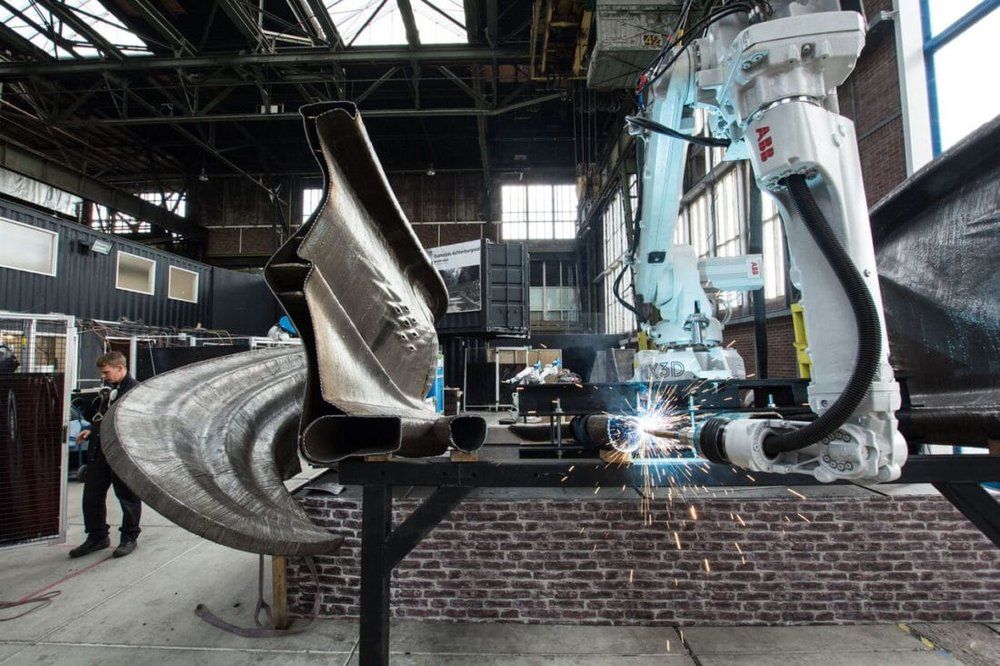
- This bridge was first presented at Dutch Design Week Eindhoven 2018, where the project won the Dutch Design Award and the Audience Award. After that, the finished bridge lay in storage for another three years: first, in anticipation of the reconstruction of the canal, then due to the coronavirus pandemic and lockdown.
What does it mean
In recent years, there has been an active development of 3D printing technology in construction. The Netherlands seems to be on a roll with this trend, with the first fully 3D-printed residential building in the EU populated in the suburbs of Eindhoven in early May, followed by the opening of the world's first 3D-printed steel bridge.
We have already said that 3D printing is the future of construction and design. Compared to classic buildings, 3D printing has a number of undeniable advantages, such as short construction times, reduced economic and environmental costs, and ease of execution of complex shapes.
“This is not just about reducing and optimizing construction costs, but about giving architects and designers a new tool, a very cool new tool, with which they can rethink the design of their architecture and their projects,” notes Tim Görtjens, co-founder of MX3D, a bridge builder.
Mika Mos, member of the council of the municipality of Amsterdam, expressed the hope that this construction will also help the city attract quality new tourists:
“This could attract a new type of visitor, those more interested in architecture and design, which will change the perception of the area (famous for nightclubs and noisy parties. — RBC Trends ).”
Updated on 10/18/2022
Text
Ksenia Yanushkevich
Top of the trend
Related materials
World's first 3D printed steel bridge installed in Amsterdam
News
a robotic 3D printer using electric arc deposition technology was thrown through one of the canals in the center of Amsterdam.
 It remains only to install the sensors and weld the missing elements.
It remains only to install the sensors and weld the missing elements.
The project took nearly six years to complete. In addition to the obvious difficulties with the development of production technology, the company also faced other obstacles. Work on the metal structure itself was completed back in 2018, after which the bridge was sent to storage pending the completion of the reconstruction of the water channel, as the municipal authorities feared that the old masonry could collapse under the weight of the new structure. Then a covid surprise arrived from Wuhan, and only now they finally decided to install the bridge in the allotted place.
This is an all steel structure made by a multi-axis robotic arm with a welding machine. The consumable material, of course, is the usual welding wire, the productivity reaches about two kilograms per hour. This is the main advantages of the technology of additive manufacturing by electric arc deposition or WAAM (Wire Arc Additive Manufacturing): such a scheme is much faster and cheaper than laser or electron beam synthesis technologies on a substrate using expensive fine powders, moreover, there are no strict restrictions on the dimensions of printed materials. products. On the other hand, the resolution is not high, and the compatibility with various metals and alloys is limited, but in this particular case, both the material and the resolution are quite suitable for the task.
products. On the other hand, the resolution is not high, and the compatibility with various metals and alloys is limited, but in this particular case, both the material and the resolution are quite suitable for the task.
Designed using Autodesk Dreamcatcher CAD using topological optimization, reducing the weight of the 12-meter bridge to approximately four tons.
Designed with multiple sensors to monitor structural integrity, vibration, strain, stress and weather conditions. All this will help, on the one hand, ensure the safety of the pedestrian flow, and, on the other hand, improve the design methodology and 3D printing algorithms for future projects.
In terms of algorithms, MX3D has been offering its software developments to the commercial market since 2019. This is partly a forced measure, because due to the low payback and high costs of research and development work, the company faced serious financial difficulties. The guys decided to get additional income from licensed sales of the Metal XL software package, which provides support for the full cycle of additive manufacturing using WAAM technology - from design to 3D printing.





